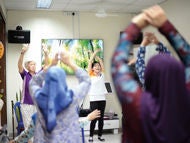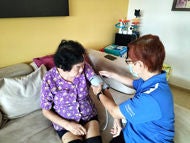
- Professor Teoh at NDCS handcrafts prosthetic eyes, blending dental expertise with artistry to restore patients' appearances and confidence after eye loss.
- Ms Lau's cancer required eye removal; her prosthetic eye, crafted using her own hair for lashes, restored her confidence and ended public scrutiny.
- Prof Teoh trains others in eye prosthetics, citing the immense joy of seeing patients regain confidence, and noting manual artistry surpasses 3D tech for realism.
At first glance, Clinical Associate Professor Teoh Khim Hean’s work might seem unlikely for a dentist.
Based at National Dental Centre Singapore (NDCS), he does not just fix teeth. He also crafts prosthetic eyes by hand, restoring not just appearances, but also confidence and dignity to patients who have lost an eye.
His journey into the delicate art of eye prosthetics began more than two decades ago during a stint in New York.
“I first became interested in crafting prosthetic eyes during my maxillofacial prosthetics attachment in New York in 2001,” recalls the 61-year-old, who is a senior consultant in prosthodontics at NDCS’ department of restorative dentistry.
“Around that time, I learnt that a one-stop clinic for prosthetic eye services was being established at Singapore National Eye Centre (SNEC). That opportunity sparked my curiosity and led me to explore the art and science behind creating ocular prostheses.”
Back in Singapore, Prof Teoh began training under a senior colleague. He realised that while the techniques share similarities with denture-making, prosthetic eye work posed a unique challenge.
It is more demanding as it requires an artistic touch, especially in painting the iris to achieve symmetry and realism.
“Unlike dentures, ocular prostheses demand meticulous colour work, pushing the limits of both clinical precision and artistry.”
Technology has not caught up with his steady hand.

While 3D printing and scanning have advanced rapidly in many medical fields, when it comes to crafting a lifelike iris – particularly for Asian eyes with their subtle undertones – manual craftsmanship remains unrivalled.
“Current 3D scanning technology is limited in its ability to capture the intricate depth and subtle colour gradations found in a real iris. It records mostly surface data,” says Prof Teoh.
In contrast, hand-painting an iris involves layering multiple hues to recreate the complexity and depth of natural eye colour.

There are two types of eye prosthetics – ocular prosthesis and orbital prosthesis. An ocular prosthesis replaces just the eyeball, while an orbital prosthesis replaces the entire eye area, including the eyelids and surrounding tissues.
Prof Teoh says: “The fees can vary for different patients depending on the extent of their condition and their subsidy status.”
The most common condition that requires an eye prosthetic is eye trauma from accidents, injuries or surgical complications. Other causes include infections, cancer and congenital or developmental conditions.
Among the many cases Prof Teoh has handled, a few remain etched in his memory.
How a prosthetic eye gave one woman back her confidence
One of them is Ms Lau Neng Duan, whose courage and resilience have left a lasting impression.
At 22, she was diagnosed with a rare cancer of the left lacrimal gland, the gland that produces tears. What she thought was a harmless stye on her lower eyelid turned out to be something far more serious.
“It was painless and I thought it would go away on its own,” recalls Ms Lau, who is now 44 years old and works as a senior administrative executive at a tertiary institution. “But after months of seeing doctors and trying creams, it just got bigger.”
A biopsy confirmed it was cancer, and it had already spread to the lymph nodes in front of her ear.
“To prevent further spread and save my life, the only option was to remove my left eye,” says Ms Lau, who was studying at Ngee Ann Polytechnic (NP) at the time.
The surgery, which involved the removal of affected lymph nodes, was life-saving but emotionally devastating.
During her month-long hospital stay, she struggled to come to terms with the loss and even had thoughts of ending her life. It was her mother who became her anchor during that dark period, encouraging her to stay strong and live positively.
After the surgery, she underwent 38 sessions of radiation therapy.
When she eventually returned to NP to continue her studies, she was nervous about facing the public. She wore sunglasses to hide her appearance, but she could still feel people’s stares.
“There were also times when strangers would ask my mum what was wrong with me. Kids would point. It was hurtful,” she recalls.
“When I finally got my prosthetic eye, it changed everything. Nobody questioned me about my eye any more,” she says.
In 2007, she graduated with a diploma in information technology from NP.
The orbital eye prosthesis not only restored her confidence, but also gave her back a sense of normality. “Before that, I was rejected from a job as a web administrator because of my missing eye. People do judge based on appearances,” she says.
How a lifelike eye is crafted, one detail at a time
The process of creating a custom eye prosthesis spans multiple appointments and involves four key stages.
It starts with taking an impression of the eye socket or eye defect area, and painting an iris to match the patient’s natural eye.
Then comes the fabrication of a wax model of the artificial eye and adjusting the position of the iris for symmetry.

The artificial eye is then processed into acrylic, hand-painted with blood vessels and colour, and finally polished.
The next stage involves sculpting the eyelids and surrounding tissues with the artificial eye in place.
Prof Teoh typically carries out this work every Friday at SNEC.
Matching colour, size and movement requires a careful eye and steady hand.
“The iris is painted to replicate the natural eye’s size and shade, usually slightly smaller to compensate for the magnifying effect of the clear acrylic overlay,” explains Prof Teoh.
“We also carefully choose the pupil size based on ambient lighting, as natural pupils dilate and constrict.”

Depending on the type of prosthesis made, a person’s own hair may be used to create the eyelashes. However, if the eyelids are still intact, this step is not necessary.
In Ms Lau’s case, her hair was used to make the eyelashes for her orbital eye prosthesis. The prosthesis is held in place to her face via magnetic attachments supported by implants in the surrounding bone.
In terms of movement, the artificial eye sits on an implant anchored by the patient’s eye muscles.
While it will not move as fully as a natural eye, it can achieve some coordinated motion through contact and muscular influence, notes Prof Teoh.
For Ms Lau, however, the cancer had damaged the nerves and muscles around her left eye, so her orbital eye prosthesis remains static.
While a prosthetic eye cannot restore vision, it restores something equally important.
“It plays a crucial role in psychological healing. A well-crafted prosthesis helps patients regain dignity, rebuild confidence and reintegrate into daily life. By closely mimicking a real eye, it also prevents social stigma and restores a sense of normality,” says Prof Teoh.
Typically, an ocular eye prosthesis lasts five to seven years for adults, but children need more frequent replacements as they grow.
The lifespan of orbital eye prostheses, which are made of silicone, typically ranges from two to three years, depending on how often they are used and how much exposure they get to external elements.
Patients like Ms Lau, who have an orbital eye prosthesis, are typically advised to remove and clean the prosthesis daily. If cleaning is not done thoroughly, it can lead to swelling around the implant, says Prof Teoh.
Ms Lau sees him at least twice a year for a review.
During these appointments, he assesses the condition, fit and overall appearance of the prosthesis. Colour touch-ups are also done when necessary to maintain a natural look.
Training more prosthetic-eye artisans
Beyond his clinical work, Prof Teoh is committed to passing on his skills.
He is training two students and has developed fellowship programmes to build expertise in countries such as Malaysia, Indonesia, Thailand, India, Egypt and Brazil.
His team – including the dental technicians he has taught to do some of this work – has conducted lectures and hands-on workshops in many of these countries. Most recently, they visited University of Malaya in Kuala Lumpur in December.
“We take along a skilled technician to demonstrate iris painting, mould-taking and other core skills. The aim is to inspire the next generation of specialists in this delicate and rewarding field.”
In Singapore, very few prosthodontists choose to specialise in hand-crafted ocular prosthetics, says Prof Teoh.
This work, he adds, requires not only medical knowledge and technical skill, but also compassion, patience and artistic ability.
After more than 20 years, what keeps him going?
“It brings me immense joy,” he says. “Seeing a patient walk away with newfound confidence, comfort and pride in his or her appearance reminds me of the value and purpose of this work.”
To view the online article click here.
The Straits Times © Singapore Press Holdings Limited. Permission required for reproduction.



















